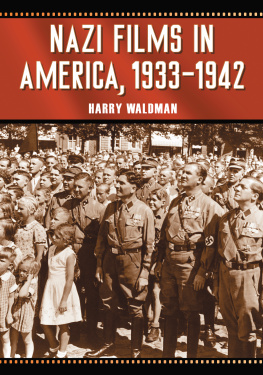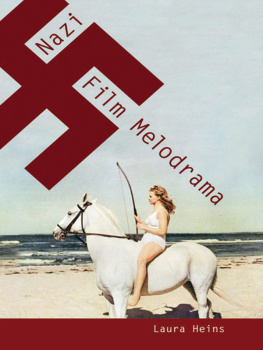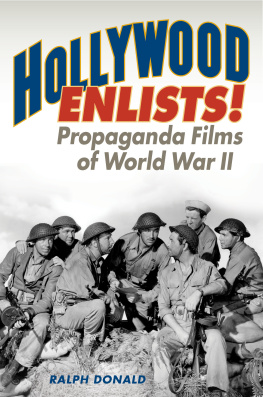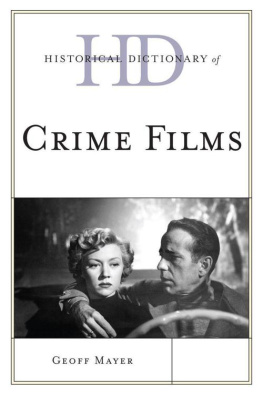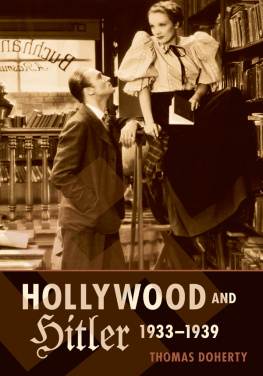
Also by HARRY WALDMAN AND FROM MCFARLAND
Scenes Unseen: Unreleased and Uncompleted Filmsfrom the Worlds Master Filmmakers, 19121990 (2014; paperback 1991)
Maurice Tourneur: The Life and Films (2001; paperback 2008)
Missing Reels: Lost Films of Americanand European Cinema (2000; paperback 2008)
Nazi Films in America,19331942
HARRY WALDMAN

McFarland & Company, Inc., Publishers
Jefferson, North Carolina
The present work is a reprint of the illustrated case bound edition of Nazi Films in America, 19331942, first published in 2008 by McFarland.
LIBRARY OF CONGRESS CATALOGUING DATA ARE AVAILABLE
BRITISH LIBRARY CATALOGUING DATA ARE AVAILABLE
e-ISBN: 978-1-4766-8079-8
2008 Harry Waldman. All rights reserved
No part of this book may be reproduced or transmitted in any formor by any means, electronic or mechanical, including photocopyingor recording, or by any information storage and retrieval system,without permission in writing from the publisher.
Cover photograph: Pour le Mrite, the first air show in Nazi Germany
McFarland & Company, Inc., Publishers
Box 611, Jefferson, North Carolina 28640
www.mcfarlandpub.com
To my father,
Carl
PREFACE
Its impossible to imagine any Nazi film circulating in the U.S. today. There was a time, however, when the opposite was true. From 1933 until the U.S. entered World War II, nearly 500 Nazi films were shown in America theatres. That represents nearly half the number of films the Nazi regime produced from 1933 to 1945. The films are described as Nazi for many reasons. Joseph Goebbels commissioned them; they were produced by Germanys top studios; they featured prominent German, proGerman, and Nazi-party actors, directors, and technicians; or they had been quietly, if not secretly, co-produced with nonGerman studios. Most importantly, the films were Nazi films because nearly all featured no Jews yet had antiSemitic plot lines. The films masqueraded as cinema, the filmmakers as artists.
The critical reaction by the New York Times, Variety, the Chicago Tribune, the New Yorker, Time, Motion Picture Herald and other outlets inside the U.S. and abroad was often indifference and ignorance. While its true that, to assuage concerns, Nazi Germany also made apparently entertaining films and released preHitler productions, it was, nonetheless, all quiet on the home front regarding clearly racist German films, which made the regime money and heartened its supporters.
The films and their filmmakers were only pieces of the picture puzzle that was Nazi Germany. Yet from their most musically entertaining to their most vile productions, just about all their films implied one thing: a world without Jews. The filmmakers and their films were signaling the future of Europes Jews.
Nazi Films in America, 19331942 is the first book to detail the regimes antiSemitic feature films, documentaries, and shorts released in the U.S.; to examine the careers of major directors, stars, and technicians; to emphasize the centrality of music in German films of the era; and to investigate the central role played by the American distributor Casino Film Exchange, especially in New York, even after World War II began.
I thank David and Lorraine Swerdloff for reading the manuscript and copying stills; Richard Hamilton for his computer wizardry; Henry Okun for translations of German material from the LIBRARY OF CONGRESS; Madeleine Matz of the LIBRARY OF CONGRESS for guidance to German collections and stills; Ellis Fabian and Steve Shirey for their spirited interest; Michael Lavin and Carol Givner for their belief in the project; and my dear friend Michael Zamm, my daughter Laura, and son Jonathan for their unalloyed encouragement. I thank my wife Susan for her editing, and for her fortitude in the face of my apparently endless research (at the National Archives, LIBRARY OF CONGRESS, and Georgetown University) and chatter on this subject.
INTRODUCTION
The function of propaganda is ... not to weigh and ponder the rights of different people, but exclusively to emphasize the one right which it has set out to argue for. Its task is not to make an objective study of truth, in so far as it favors the enemy, and then set it before the masses with academic fairness; its task is to serve our own right, always and unflinchingly.
In 1933, eight years after Adolf Hitler wrote these words, Mein Kampf sold 1.5 million copiesand German filmmakers were among those taking its words to heart. They put new energy into idealizing pure-bred institutions and traditionsand demonizing nonGermans. But one group received special attentionJews. The Nazis cinematic attack on Jews was breathtaking. Although many German films of the Nazi era have been characterized as merely entertainingand have been described this way ever sincea closer look reveals that a majority of the films produced in Nazi Germany were antiSemitic. And many of these German films were screened in the United States before the Third Reich was destroyed.
In the film-going world, it was no longer news that a movie could reveal muchsometimes even more than its filmmaker intendedabout the society in which it was made. D.W. Griffiths Birth of a Nation (1916) depicted the sinister underside of patriotism by glamorizing the Klan. Sergei Eisensteins Potemkin (l925) pilloried Czarist rule while romanticizing the Communist Revolution. But somehow, with German films, the world missed the overt and covert messages they contained. That was at least the case in the United States.
A few months after Hitler assumed power, the first German-language films extolling the new German state and supporting an increasingly vocal racism were released in the U.S. The pace of these Third Reich imports increased as the Nazis consolidated their rule. The outbreak of the war in Europe did not impede the distribution and release in the United States of films from Hitlers Germany. Only the U.S. entry into World War II put a stop to that.
Between 1933 and 1942, nearly five hundred German-language films were shown in the States. That number represented nearly half of all foreign-language film imports to America during these years. The bare essentials of these Nazi films were to manipulate and steer emotions along guided paths; to impress and frighten; and to predict the future. German filmmakers stood with the leaders of the regime in these efforts. At the time and later they pleaded that they had no choicethey would lose their jobs, suffer violence, be shipped off to concentration camps, or be executed.
American film critics and others may have noticed the open antiSemitism in a few German productions, but they missed the subtle antiSemitism and racist content in nearly all of them. When they did sense racist content, they dismissed it as mere propaganda, inept and ineffective. In the 1930s, in fact, the U.S. was no friend to Jewish immigrants. It closed its doors to Jews seeking escape from Hitlers Germany. Its antiJewish stance did not contradict the Nazi worldview regarding nonAryans.
Besides, importing German films was good business, serving the interests of American distributors and motion picture producers afraid of alienating one of the biggest German-speaking audiences outside the Third Reich.
At the same time, a seemingly innocent breed of German film also made its appearance. The German films that screened in the U.S. between 1933 and the end of World War II included scores of preHitlerthat is, Weimarproductions. By marking these films for distribution in America, the Nazis ameliorated their image abroad, hiding the growing terror within the Third Reich and obscuring Nazi threats to Germanys neighbors and to the world.
Next page
